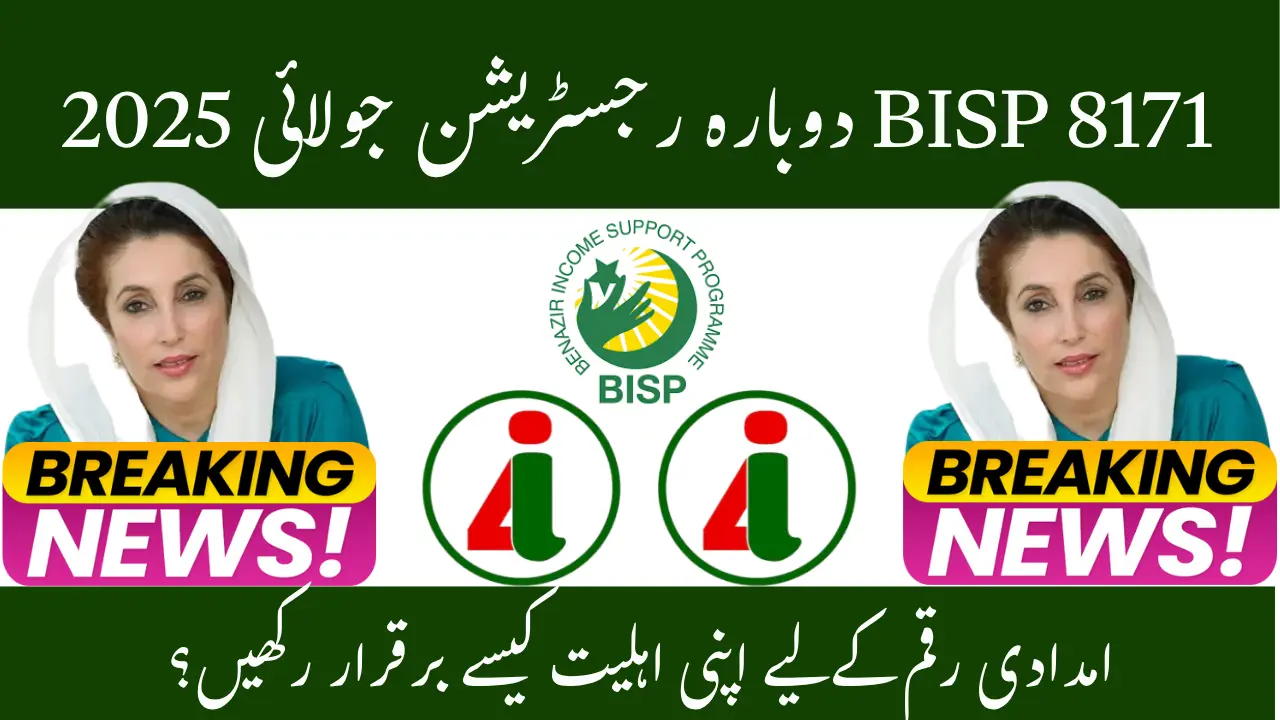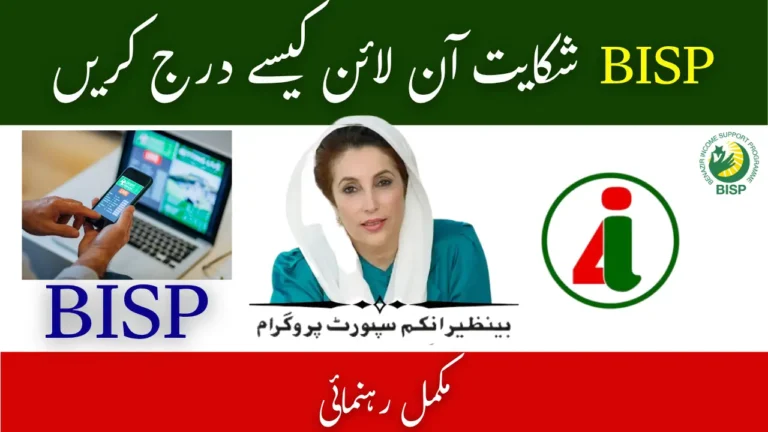For millions of Pakistani families, the Benazir Income Support Program (BISP) isn’t just a government initiative; it’s a lifeline. It’s the quarterly payment that keeps the kitchen running, helps buy school books, or provides much-needed relief during times of illness. As we step into July 2025, BISP is rolling out crucial updates to its eligibility and payment processes, most notably through its re-registration drive. This isn’t just bureaucracy; it’s a necessary step to ensure that the financial support reaches those who truly need it most, cutting out inefficiencies and maximizing impact.
If you’re a beneficiary, or aspiring to be one, understanding this re-registration process is paramount. It’s about securing your family’s future, ensuring the flow of vital funds, and navigating the system with confidence.
Why Re-registration Now? The Evolving Landscape of BISP in 2025
BISP operates on a dynamic model, continuously striving to keep its beneficiary database updated and accurate. Life circumstances change – families grow, incomes fluctuate, and new challenges emerge. A re-registration drive, often referred to as a “Dynamic Survey” or simply an update of your National Socio-Economic Registry (NSER) profile, is BISP’s way of ensuring its data reflects the current reality on the ground.
In July 2025, this re-registration holds particular significance due to several key policy shifts:
- Targeted Aid: The government’s renewed focus is on ensuring that only the most vulnerable families receive assistance. This means a more stringent re-evaluation of household income and assets.
- Exclusion of Government Employees: A major update for 2025 is the explicit disqualification of households with any member employed by the government or receiving a government pension. This policy aims to free up funds for those without a stable source of income.
- Combating Fraud and Misuse: Regular re-registration helps BISP identify and remove ineligible beneficiaries who may have slipped through the cracks, or whose circumstances have changed, thereby curbing fraud and ensuring responsible use of public funds.
- Adapting to Economic Realities: With the cost of living continuously fluctuating, regular data updates allow BISP to assess the real needs of families and potentially adjust payment structures accordingly in the future.
This re-registration isn’t punitive; it’s proactive. It’s BISP’s commitment to fairness and efficiency, ensuring that every rupee disbursed makes a genuine difference.
Understanding Your Status: The 8171 Portal and SMS System
Before you rush to re-register, your first step should always be to check your current eligibility status. BISP’s 8171 SMS service and its dedicated web portal (8171.bisp.gov.pk) are your primary tools for this. Both have received significant upgrades in 2025 to make them more user-friendly and reliable.
How to Check Your Status (July 2025 Guide):
- Via SMS (8171):
- Open your mobile phone’s messaging application.
- Type your 13-digit CNIC number (without any dashes or spaces).
- Send the SMS to 8171.
- Wait for a reply message. This usually arrives within a few minutes.
- What the reply means:
- “Eligible for BISP program”: Great news! Your status is active, and you should be expecting your quarterly payment of PKR 13,500 (or potentially PKR 27,000 if it’s a double payment for a missed previous installment in August).
- “Under Review”: Your data is being processed, or BISP requires more information. Be patient, but if the status doesn’t change after a few weeks, consider visiting your nearest BISP office.
- “Ineligible”: This means you currently do not qualify. This could be due to exceeding income limits, owning significant assets, or the recent policy on government employment/pension.
- “No Record Found”: Your details might be missing or outdated in the BISP system. This is a clear indicator that you need to initiate the re-registration process.
- Crucial Tip: Only trust messages from the official 8171 number. Be vigilant against scam messages asking for personal details or money. BISP services are always free.
- Via the 8171 Web Portal (8171.bisp.gov.pk):
- Open a web browser on your phone or computer and go to 8171.bisp.gov.pk.
- Locate the section for checking eligibility or payment status.
- Enter your 13-digit CNIC number precisely (no dashes).
- Complete the CAPTCHA challenge (this is a security measure to prove you’re not a robot).
- Click on the “Submit” or “Maloom Karen” button.
- The portal will display your current status, similar to the SMS reply, often with more detailed information.
- New for 2025: The portal is now faster, more mobile-friendly, and offers a more intuitive experience, even for those with limited digital literacy.
The Re-registration Journey: A Step-by-Step Guide for July 2025
If your status check indicates “No Record Found,” “Under Review” for an extended period, “Ineligible” (and you believe your circumstances warrant reconsideration), or if you’ve received an SMS specifically asking you to update your NSER profile, then it’s time for re-registration.
Step 1: Gather Your Essential Documents
Preparation is key to a smooth re-registration process. Ensure you have the following documents ready before visiting a BISP office:
- Original CNIC (National Identity Card): This is paramount. Ensure it is valid and unexpired. An expired CNIC will prevent you from completing the process. If it’s expired, visit a NADRA office immediately to renew it.
- Children’s B-Forms (Child Registration Certificate): If you have children, especially if they are or will be enrolled in the Benazir Taleemi Wazaif (Conditional Cash for Education) program, their B-Forms are mandatory.
- Proof of Income/Unemployment (if applicable): While not always explicitly required for the initial survey, having proof of your low income (e.g., a letter from a former employer, a utility bill indicating low consumption, or simply being able to articulate your household income) can strengthen your case.
- Disability Certificate (if applicable): If any family member has a disability, their official disability certificate is vital. This can often lead to a slightly higher PMT (Poverty Means Test) score threshold for eligibility (up to 37, as opposed to the general 34).
- Death Certificate (for widows): If you are a widow, your late husband’s death certificate is important for verification.
- Divorce Decree (for divorced women): For divorced women heading households, a divorce decree can be necessary.
- Recent Utility Bill (optional but helpful): A recent electricity or gas bill can sometimes help confirm your address and household composition.
Step 2: Visit Your Nearest BISP Tehsil Office or NSER Registration Center
Currently, the full re-registration (Dynamic Survey) cannot be completed online. You must visit a physical BISP Tehsil office or a designated NSER Registration Center.
- Find Your Center: You can locate your nearest office by checking the official BISP website (bisp.gov.pk) or by calling their helpline (0800-26477). Local community members often know the locations of these centers as well.
- Be Prepared for the Survey: At the office, you will undergo the National Socio-Economic Registry (NSER) survey. This is essentially a detailed questionnaire about your household’s socio-economic status.
- Answer Honestly: Be completely truthful when providing information about your income, family size, assets (like vehicles, land, property), and living conditions. Providing false information can lead to permanent disqualification and potential legal repercussions.
- Dynamic Survey: This isn’t a one-time survey; BISP is transitioning to a “dynamic registry,” meaning your information can be updated periodically to reflect changing circumstances. If you’ve been asked to update your profile, it’s likely part of this ongoing process.
- Biometric Verification: After completing the survey, you will be required to provide your thumb impression for biometric verification. This crucial step confirms your identity and is a key anti-fraud measure.
- Troubleshooting Biometric Failure: If your fingerprints fail to verify (which can happen due to various reasons, including dry skin or unupdated data), do not panic. The BISP staff will guide you. You might need to visit a NADRA office to update your biometric data, and then re-attempt verification at the BISP center.
Step 3: Obtain and Keep Your Acknowledgement Slip
Once your data has been successfully entered and biometric verification completed, ensure you receive an acknowledgement slip. This slip is your proof that you have completed the re-registration process. Keep it safe as it may be required for future inquiries.
Step 4: Await Confirmation from 8171
After completing the survey and verification, you will need to wait for an SMS confirmation from 8171. This message will inform you whether your re-registration has been successful and if you are now eligible for payments. This waiting period can vary, sometimes taking a few weeks. If you do not receive an SMS after a reasonable period, contact the BISP helpline or revisit your BISP office for a status update.
What BISP Payment Re-registration Means for Beneficiaries
This re-registration process carries significant implications for both existing and potential beneficiaries:
- For Existing Beneficiaries: If you are an active beneficiary and receive a prompt to re-register (or if your status becomes “Under Review” or “Ineligible”), completing the NSER dynamic survey is mandatory to continue receiving payments. Ignoring this could lead to suspension or termination of your financial aid. It’s BISP ensuring that the aid continues to flow to you.
- For New Applicants: The re-registration windows are also opportunities for new families who have recently fallen into poverty or meet the revised eligibility criteria to apply for the program. This means BISP is continually accepting new entries based on verified need.
- Enhanced Trust and Transparency: By regularly cleaning its beneficiary list and utilizing biometric verification, BISP aims to build greater public trust in the program’s integrity. Beneficiaries can be more confident that the aid is reaching its intended recipients, minimizing corruption and wastage.
- Access to Other BISP Initiatives: Successful re-registration often ensures continued access not just to the core BISP Kafalat program but also to other linked initiatives like Benazir Taleemi Wazaif (for education stipends) and the Nashonuma Program (for health and nutrition).
Common Issues and Troubleshooting Tips for July 2025
Even with streamlined processes, beneficiaries might encounter issues. Here’s how to navigate them:
- “SMS Not Delivering” or “No Reply from 8171”:
- Solution: Ensure your mobile number is registered under your CNIC. If not, visit your telecom service provider or a NADRA e-Sahulat center to link it. Try sending the SMS again. If the issue persists, visit your nearest BISP office.
- “CNIC Expired or Blocked”:
- Solution: This is a common hurdle. Immediately visit your nearest NADRA office to renew or unblock your CNIC. You cannot receive payments or complete verification with an invalid CNIC.
- “Biometric Verification Failure”:
- Solution: If your thumb impression doesn’t match, visit a NADRA office to update your fingerprints. Sometimes, simple issues like dry hands can cause this; try moisturizing your hands before visiting.
- “Application Under Review Too Long”:
- Solution: While some waiting is normal, if it’s excessively long (e.g., more than 6-8 weeks), visit your BISP Tehsil office with your acknowledgement slip to inquire about the status.
- “Incorrect Family Information in NSER”:
- Solution: If you notice discrepancies in your family’s data from a previous NSER survey, or if your circumstances have changed (e.g., new births, deaths, marriages), inform the BISP staff during re-registration so they can update your profile accurately.
- “Asked to Pay a Fee for Registration/Payment”:
- Solution: This is a scam. BISP services are 100% free. Never pay anyone. Immediately report such incidents to the BISP helpline (0800-26477) or the nearest BISP office with details of the person demanding money.
- “Received Less Than the Full Payment (PKR 13,500)”:
- Solution: Always count the cash immediately at the payment counter. If the amount is short, refuse to accept it and immediately report it to the BISP helpline while still at the payment point. Always ask for a receipt.
Quick Q&A: 8171 BISP Re-registration July 2025
The Benazir Income Support Program (BISP) is a very important help for many families. With July 2025 bringing some new changes, especially about re-registration, you might have some common questions. Don’t worry, here are simple answers.
1. Q: Why do I need to re-register with BISP in July 2025? Haven’t I done this before?
A: Think of it like this: BISP wants to make sure its money goes to the families who really need it right now. Life changes, right? Maybe your family’s income is different, or you have new family members. Also, there’s a new rule this year: if anyone in your family works for the government or gets a government pension, you might not be able to get BISP money anymore. So, re-registering helps BISP check your latest information. This way, they can keep their records correct and make sure the help goes to the families who are struggling the most. It’s about being fair.
2. Q: How can I check if I even need to re-register or if I’m still able to get payments?
A: This is the first and most important step! It’s very easy.
- By SMS: Open your phone messages, type your 13-digit CNIC number (no dashes or spaces), and send it to 8171. You will get a message back telling you if you are eligible, if your record is missing, or if you need to update your info.
- By Website: If you have internet, go to the official BISP website. Put your 13-digit CNIC number there, do the small security check (CAPTCHA), and click submit. It will show your current status. If either one tells you to re-register, or says “No Record Found,” or “Under Review” for a long time, then yes, you need to re-register.
3. Q: What papers do I need to take with me for this re-registration?
A: Don’t go without your documents! Here’s a simple list:
- Your original CNIC (National Identity Card). Make sure it’s not expired! If it is, get it renewed at NADRA first.
- The B-Forms (identity cards for children) for all your children.
- If you are a widow, bring your late husband’s death certificate.
- If you are divorced, bring your divorce papers.
- If anyone in your family has a disability, bring their official disability certificate.
4. Q: Where do I go to re-register, and what will happen there?
A: You need to go to your nearest BISP Tehsil Office or a special NSER Registration Center. You can ask people in your area where it is, or call the BISP helpline (0800-26477).
When you get there, BISP staff will ask you questions about your family’s income, house, and what you own. This is called the NSER survey. Be honest with your answers. After the survey, you’ll need to put your thumbprint for a biometric check. This confirms it’s really you! Make sure your hands are clean and dry. And very important: ask for a receipt when you’re finished. Keep it safe.
5. Q: How will I know if my re-registration worked, and when will I get my money?
A: After you finish the survey and thumbprint check, you’ll need to wait for a message. BISP will send you an SMS from 8171 to tell you if your re-registration was successful and if you can get payments. This might take a few weeks.
If you are approved, you will usually get PKR 13,500 for this time. Sometimes, if you missed a payment before, you might even get double (PKR 27,000) in August 2025. You’ll get another SMS from 8171 telling you when and where to pick up your money (like at a Pakistan Post Office or a special bank agent). Remember, never pay anyone to get your money; it’s always free!
The Future of BISP: Sustained Impact
The 8171 BISP Re-registration July 2025 is more than just a procedural update; it’s a testament to the program’s commitment to continuous improvement. By embracing technology, refining eligibility, and prioritizing transparency, BISP aims to build an even more robust and responsive social safety net.
For deserving families, this means a clearer path to sustained financial support, greater dignity in the collection process, and the assurance that the program is truly working for them. Your proactive engagement in this re-registration process ensures that this vital lifeline continues to reach its intended destination, empowering households and contributing to a more resilient and equitable Pakistan. Don’t delay your re-registration if required – your family’s future depends on it.







